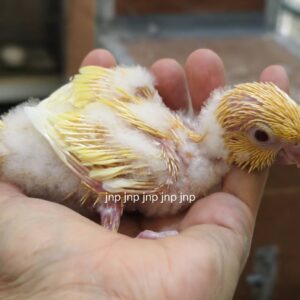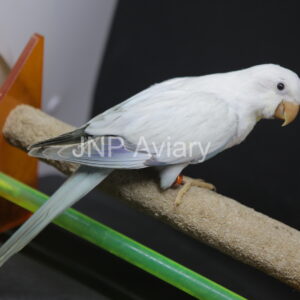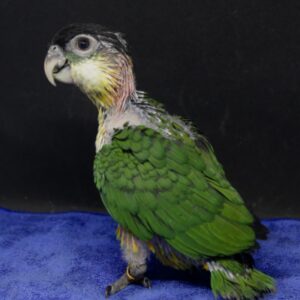ไลน์โอเล็ต lineolated parakeet นกแก้วเล็กแสนน่ารัก
Quote from JNP aviary on February 5, 2023, 10:32 amมารู้จัก นกแก้วไลน์โอเล็ต ลินนี่โอเลเต๊ด lineolated parakeet นกแก้วเล็กแสนน่ารัก เลี้ยงง่าย เสียงเงียบ พูดได้
นกแก้วไลน์โอเล็ต ลินนี่โอเลเต็ด Lineolated Parakeet
The barred parakeet (Bolborhynchus lineola), also known as lineolated parakeet, Catherine parakeet or 'linnies' for short, is a small parrot found disjunctly in highland forests from southern Mexico to Panama, in the Andes from western Venezuela to southern Peru and Bolivia, the Santa Marta Mountains in Colombia and the Venezuelan Coastal Range. Its plumage is mostly green with multiple black and dark green stripes or bars, and it has a pale-horn coloured beak. The dark stripes vary in prominence between its two subspecies. Several colour mutants are available in aviculture.
There are two subspecies of the Lineolated or barred parakeet:
Bolborhynchus lineola
Bolborhynchus lineola lineola
Bolborhynchus lineola tigrinus – which has more prominent dark stripesDescription
A natural coloured pet linnie
The barred parakeet is about 16 cm (6.5 in) in length and has a weight of about 42 to 52 grams. It is mostly green and has black stripes (or bars) over its upper-parts, except on the top of the head. Its lower-parts are olive-green with very dark green stripes on its sides. The shoulder of its wings is black, there is some blue on the under-side of its wings, and its tail is dark green. The irises are dark brown and its beak is horn coloured. Its legs are pink. Juveniles have less-marked dark stripes, which darken with age. Males and females are generally similar in external appearance, but males may sometimes have more marked black stripes than the female. Usually, however, there is no discerning trait to differentiate sex and sexing must be done surgically or through blood tests. The two subspecies differ in the prominence of the dark stripes.Habitat and status
Their habitat is the forests and mountains up to an elevation of roughly 3,300 m (2.1 mi) above sea level. They spend some of their time on the ground,but sleep high in the trees. They are tolerant of cold and have been seen taking snow baths.The barred parakeet has a large population that is thought to be stable.
Behavior and breeding
There are usually two to four eggs in a clutch, which hatch after about 18–21 days of incubation. Chicks leave the nest at about five weeks after hatching.Lineolated parakeets are found in the wild in groups of six to thirty, although bigger groups (up to 150 birds) are known. They eat fruit, dried and germinated seeds, and insect larvae.
Lineolated parakeets are known for their calm dispositions and peculiar postures. Unlike many birds, lineolateds typically rest in a near horizontal position with their heads almost in line with their tails. They are generally very calm birds and typically mumble quietly, and their calls are not high-pitched or piercing to the ear.
Aviculture
Barred parakeets are popular as pets because of their quiet and even-tempered disposition, and also because many colour mutations are available.Green series birds include the normal green (wild type), dark green, olive, and the green series ino called lutino (yellow).
Turquoise series birds include turquoise, cobalt, mauve, and the turquoise ino called creamino (white). Greywing, where the barring and overall color is diluted, is another mutation that can fall on any color mutation, even the inos. Violet, misty, and cinnamon types are seen in European aviculture, but rare in the United States. Their average lifespan is about 10 years, but individual birds have been known to live up to 15 years.[citation needed] They are talented mimics of human speech.
One of the most recognizable and entertaining characteristics of barred parakeets is that they enjoy bathing and being misted with water. Barred parakeets notably enjoy these mist baths; they will hang upside down and open their wings eagerly. Pet linnies are also known to have a unique trait of liking to burrow or hide in or under clothing for hours on end, and will sometimes fall asleep in their found hiding places
Colour Mutations
Lutino
Turquoise
Grey/Mauve
Blue/Cobalt
มารู้จัก นกแก้วไลน์โอเล็ต ลินนี่โอเลเต๊ด lineolated parakeet นกแก้วเล็กแสนน่ารัก เลี้ยงง่าย เสียงเงียบ พูดได้
นกแก้วไลน์โอเล็ต ลินนี่โอเลเต็ด Lineolated Parakeet
The barred parakeet (Bolborhynchus lineola), also known as lineolated parakeet, Catherine parakeet or 'linnies' for short, is a small parrot found disjunctly in highland forests from southern Mexico to Panama, in the Andes from western Venezuela to southern Peru and Bolivia, the Santa Marta Mountains in Colombia and the Venezuelan Coastal Range. Its plumage is mostly green with multiple black and dark green stripes or bars, and it has a pale-horn coloured beak. The dark stripes vary in prominence between its two subspecies. Several colour mutants are available in aviculture.
There are two subspecies of the Lineolated or barred parakeet:
Bolborhynchus lineola
Bolborhynchus lineola lineola
Bolborhynchus lineola tigrinus – which has more prominent dark stripes
Description
A natural coloured pet linnie
The barred parakeet is about 16 cm (6.5 in) in length and has a weight of about 42 to 52 grams. It is mostly green and has black stripes (or bars) over its upper-parts, except on the top of the head. Its lower-parts are olive-green with very dark green stripes on its sides. The shoulder of its wings is black, there is some blue on the under-side of its wings, and its tail is dark green. The irises are dark brown and its beak is horn coloured. Its legs are pink. Juveniles have less-marked dark stripes, which darken with age. Males and females are generally similar in external appearance, but males may sometimes have more marked black stripes than the female. Usually, however, there is no discerning trait to differentiate sex and sexing must be done surgically or through blood tests. The two subspecies differ in the prominence of the dark stripes.
Habitat and status
Their habitat is the forests and mountains up to an elevation of roughly 3,300 m (2.1 mi) above sea level. They spend some of their time on the ground,but sleep high in the trees. They are tolerant of cold and have been seen taking snow baths.
The barred parakeet has a large population that is thought to be stable.
Behavior and breeding
There are usually two to four eggs in a clutch, which hatch after about 18–21 days of incubation. Chicks leave the nest at about five weeks after hatching.
Lineolated parakeets are found in the wild in groups of six to thirty, although bigger groups (up to 150 birds) are known. They eat fruit, dried and germinated seeds, and insect larvae.
Lineolated parakeets are known for their calm dispositions and peculiar postures. Unlike many birds, lineolateds typically rest in a near horizontal position with their heads almost in line with their tails. They are generally very calm birds and typically mumble quietly, and their calls are not high-pitched or piercing to the ear.
Aviculture
Barred parakeets are popular as pets because of their quiet and even-tempered disposition, and also because many colour mutations are available.
Green series birds include the normal green (wild type), dark green, olive, and the green series ino called lutino (yellow).
Turquoise series birds include turquoise, cobalt, mauve, and the turquoise ino called creamino (white). Greywing, where the barring and overall color is diluted, is another mutation that can fall on any color mutation, even the inos. Violet, misty, and cinnamon types are seen in European aviculture, but rare in the United States. Their average lifespan is about 10 years, but individual birds have been known to live up to 15 years.[citation needed] They are talented mimics of human speech.
One of the most recognizable and entertaining characteristics of barred parakeets is that they enjoy bathing and being misted with water. Barred parakeets notably enjoy these mist baths; they will hang upside down and open their wings eagerly. Pet linnies are also known to have a unique trait of liking to burrow or hide in or under clothing for hours on end, and will sometimes fall asleep in their found hiding places
Colour Mutations
Lutino
Turquoise
Grey/Mauve
Blue/Cobalt





